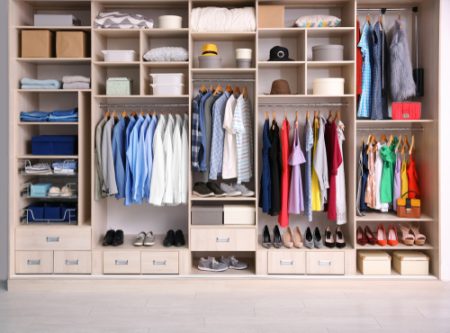When you look at your wardrobe, do you quickly shut the door?
Does it make you feel anxious or downright depressed?
Do you spend precious minutes in the morning searching for a match to a shoe or a belt to go with your pants?
If you answered ‘yes’ to any of these questions, then organising your wardrobe better may be just what you need.
Just like any other area of your home, decluttering takes time. Choose a moment when you can evaluate your clothing and accessories, decide what you actually use or can’t part with and arrange the contents so that they’re attractively and conveniently presented.
Here’s a step-by-step guide to decluttering and organising your wardrobe.
You’ll feel as if a weight has been lifted from your shoulders after you complete this project.
Step 1: Evaluate Your Needs
Consider what will help in reorganisation.
- Do you have too many clothes?
- Are items in disarray?
- Do you need more space to house your clothing?
- Do you need organisers to better store and display shoes, jewellery, purses and other accessories?
An impartial evaluation is absolutely necessary as you go through this process.
Step 2: Cull
Set some time aside to examine every article of clothing, all your shoes and all accessories. Be ruthless in your decision-making. Ask yourself these questions, and answer honestly.
When was the last time I used this item?
If you use something regularly, put it into a ‘keep’ stack. If you haven’t worn something for more than two years, be honest. Do you think you will use it again?
Does the item fit?
If you are keeping something for that hopeful time when you might lose enough weight to fit into it, be realistic. Chances are, you won’t use it. Put it into a ‘discard’ pile.
How worn is the item?
If your favourite pair of jeans is looking tired, it may be hard to part with them. But do you really want to go to the office, a party or out on the town in torn, faded or otherwise shabby attire?
If it’s a matter of a lost button that can be quickly mended, keep it. Otherwise, get rid of it.
How many items do you need it?
You may decide that you don’t need 30 T-shirts. Don’t keep mismatched shirts and pants, outdated styles or colours that aren’t flattering.
Do seasonal clothing add to the sense of clutter?
Sort seasonal clothing into separate stacks. Coats, mittens, caps and heavy jumpers take up space. These items can be stored out of the way during off-season. Be sure to use the same impartial evaluation as you go through seasonal gear.
Step 3: Create Storage Solutions
Once you’ve sorted your garments and accessories, consider how to arrange and store them. You may want to consult a professional wardrobe designer to help you maximise space.
These consultants make use of nooks and crannies by visualising the use of available height, depth and width.
If you plan to do it yourself, look at these storage systems:
- Boxes and bins.
- Wire baskets and shelving.
- Jewellery organisers.
- Hooks and other wall-mounted hardware.
- Drawer dividers.
- Shoe racks.
Step 4: Manage Your Apparel
Arranging your apparel makes items easy to find. Keeping it arranged takes little time once you have a system in place. You can group clothing by type, such as trousers, T-shirts, shirts and dresses.
Some people like to group by colour, making it easy to match tops, pants, shoes and accessories. However you decide to arrange your space, there are ways to keep it ordered.
- Always put items back in the same place.
- Store shoes on racks, in organisers or in bins. Bins can go under the bed, organisers can go on the back of a door and racks can go anywhere.
- Fold clothing before putting it away. This helps keep the shape, makes it easier to see and uses less space.
- Keep off-season clothes in closed bins on the top shelf.
- Make use of walls and the backs of doors to add hooks for scarves, belts and jewellery.
- Label boxes and bins to make finding stored items easier.
- Mend clothing as soon as possible. Keep a mending kit near the wardrobe to make it easier to sew on buttons or repair a hole.
- Go through garments regularly. As items fade or go out of style, don’t keep them. This frees up space and keeps apparel looking smart.
If you’re considering installing a new wardrobe, contact Just Wardrobes & Storage. We come to your home for a free consultation to design a system that works with your space and budget. With just a bit of organising, you’ll open your closet door without trepidation and save time getting ready each day.


